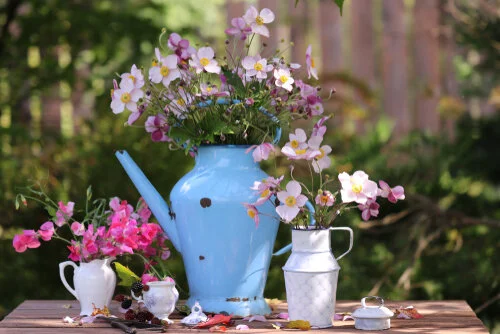Japanese Anenomes
Japanese anemones are perennial plants that really stand out in the garden from September. I was introduced to them by way of a school run that passed by a garden that is absolutely filled with them. On reflection it might be just one plant that has grown so much over years it takes over the full small sized garden! Either way its magnificent and a floral treat for anyone passing by that house.
While we know the Autumn flowering as Japanese anemones they are more likely to be correctly named as anemone x hybrida. Botanical or scientific names for plants follow the standard latin binomial system of nomenclature. The first name represents the genus and is capitalized, the second name identifies the species and is written in lowercase, and the entire name is italicized. I think the most straightforward way to look at any plant names, without thinking it’s complicated is to think of the genus as the family name or surname. You could put your own name into nomenclature to explain it easily! For Anemones the three we usually think of for cut flowers are firstly the Japanese (x Hybrida) that flower in Autumn, secondly the Anemone nemorosa (or wood anemone) the little white wildflower native to Ireland, and finally Anemone coronaria (or Poppy Anemone) that we usually sow from corms in Autumn or early in the year for Spring or early Summer flowering. There is plenty more species of Anemone of course but these are the ones I grow.
According to Allan Armitage there are approximately 70 species of Anemone. Sometimes they are known as windflower and are plants in the buttercup family of Ranunculaceae. Its good to know the family as they you have an idea of how they spread and can be propagated! For Japanese (or x hybrida) anemones, they can be divided in Autumn or Spring and also propagated by root cuttings when the plants are dormant in winter. They are known to take a couple of years to start flowering especially after division.
Best planted in well drained soils and in partial shade. Anemones are also identifiable by their compound leaf shape and the flowers that have no petals (apetalous). This means for identifying you can see there’s a gap between the flowers and the first leaves. The sepals are very beautiful. I think I have more photos of close-ups of the sepals than the flowers themselves!
Image above from “Perennials Volume 2” by Roger Philips and Martyn Rix. I added a Prinz Heinrich to my garden this year as the colour was too good to ignore! The other varieties I have are the standard pale pink and whites. In a few years once they are established more I will divide them and create a dedicated section for them.
Clare Austin in her book “Perennials New Edition” recommends a few very beautiful varieties from single to doubles, and from white to darker pinks.
References:
1) Herbaceous Perennial Plants - A Treatise on their Identification, Culture and Garden Attributes by Allan M. Armitage
2) Perennials Volume 2 Late Perennials by Roger Philips and Martyn Rix
3) Perennials New Edition by Claire Austin
4) The Wildflowers of Ireland by Zoe Devlin.
I recommend searching for the first two second hand as you can pick them up very cheaply (the first book can be very expensive for the newer editions) and the last two are new books.





